Lighthouse

Alighthouseis a tower, building, or other type of physical structure designed to emit light from a system of lamps andlensesand to serve as abeaconfornavigational aid,formaritime pilotsat sea or on inland waterways.
Lighthouses mark dangerous coastlines, hazardousshoals,reefs,rocks, and safe entries to harbors; they also assist inaerial navigation.Once widely used, the number of operational lighthouses has declined due to the expense of maintenance and the advent of much cheaper, more sophisticated, and more effective electronic navigational systems.
History[edit]
Ancient lighthouses[edit]
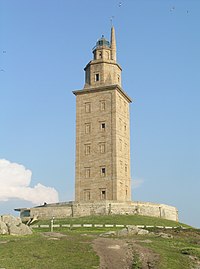
Before the development of clearly definedports,mariners were guided by fires built on hilltops. Since elevating the fire would improve visibility, placing the fire on a platform became a practice that led to the development of the lighthouse.[1]In antiquity, the lighthouse functioned more as an entrance marker to ports than as a warning signal forreefsandpromontories,unlike many modern lighthouses. The most famous lighthouse structure from antiquity was thePharosofAlexandria,Egypt,which collapsed following a series of earthquakes between 956 and 1323.
The intactTower of HerculesatA Coruña,Spain gives insight into ancient lighthouse construction; other evidence about lighthouses exists in depictions on coins and mosaics, of which many represent the lighthouse atOstia.Coins from Alexandria, Ostia, andLaodicea in Syriaalso exist.
Modern construction[edit]
The modern era of lighthouses began at the turn of the 18th century, as the number of lighthouses being constructed increased significantly due to much higher levels oftransatlanticcommerce. Advances in structural engineering and new and efficient lighting equipment allowed for the creation of larger and more powerful lighthouses, including ones exposed to the sea. The function of lighthouses was gradually changed from indicating ports to the providing of a visible warning against shipping hazards, such as rocks or reefs.
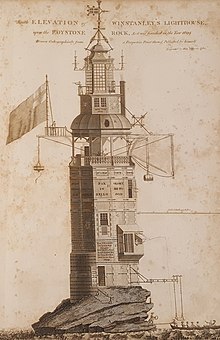
TheEddystone Rockswere a major shipwreck hazard for mariners sailing through theEnglish Channel.[2]Thefirst lighthouse built therewas an octagonal wooden structure, anchored by 12 iron stanchions secured in the rock, and was built byHenry Winstanleyfrom 1696 to 1698. His lighthouse was the first tower in the world to have been fully exposed to the open sea.[3]
Thecivil engineerJohn Smeatonrebuilt thelighthousefrom 1756 to 1759;[4]his tower marked a major step forward in the design of lighthouses and remained in use until 1877. He modeled the shape of his lighthouse on that of anoak tree,usinggraniteblocks. He rediscovered and used "hydraulic lime",a form ofconcretethat will set under water used by the Romans, and developed a technique of securing the granite blocks together usingdovetail jointsand marbledowels.[5]The dovetailing feature served to improve thestructural stability,although Smeaton also had to taper the thickness of the tower towards the top, for which he curved the tower inwards on a gentle gradient. This profile had the added advantage of allowing some of the energy of the waves to dissipate on impact with the walls. His lighthouse was the prototype for the modern lighthouse and influenced all subsequent engineers.[6]
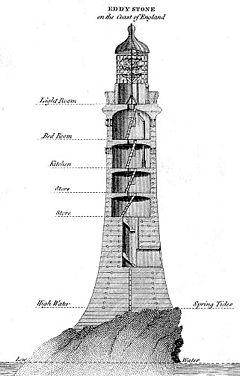
One such influence wasRobert Stevenson,himself a seminal figure in the development of lighthouse design and construction.[7]His greatest achievement was the construction of theBell Rock Lighthousein 1810, one of the most impressive feats of engineering of the age.[citation needed]This structure was based upon Smeaton's design, but with several improved features, such as the incorporation of rotating lights, alternating between red and white.[8]Stevenson worked for theNorthern Lighthouse Boardfor nearly fifty years[7]during which time he designed and oversaw the construction and later improvement of numerous lighthouses. He innovated in the choice of light sources, mountings, reflector design, the use ofFresnel lenses,and in rotation and shuttering systems providing lighthouses with individual signatures allowing them to be identified by seafarers. He also invented the movable jib and the balance-crane as a necessary part for lighthouse construction.

Alexander Mitchelldesigned the firstscrew-pile lighthouse– his lighthouse was built on piles that werescrewedinto the sandy or muddy seabed. Construction of his design began in 1838 at the mouth of theThamesand was known as theMaplin Sandslighthouse, and first lit in 1841.[9]Although its construction began later, theWyre Lightin Fleetwood, Lancashire, was the first to be lit (in 1840).[9]
Lighting improvements[edit]
Until 1782 the source of illumination had generally been wood pyres or burning coal. TheArgand lamp,invented in 1782 by the Swiss scientistAimé Argandrevolutionized lighthouse illumination with its steady smokeless flame. Early models used ground glass which was sometimes tinted around the wick. Later models used amantleofthorium dioxidesuspended over the flame, creating a bright, steady light.[10]The Argand lamp usedwhale oil,colza,olive oil[11]or othervegetable oilas fuel, supplied by agravity feedfrom a reservoir mounted above the burner. The lamp was first produced byMatthew Boulton,in partnership with Argand, in 1784, and became the standard for lighthouses for over a century.[12]
South Foreland Lighthousewas the first tower to successfully use an electric light in 1875. The lighthouse's carbonarc lampswere powered by a steam-drivenmagneto.[13]John Richardson Wighamwas the first to develop a system forgasillumination of lighthouses. His improved gas 'crocus' burner at theBaily Lighthousenear Dublin was 13 times more powerful than the most brilliant light then known.[14]
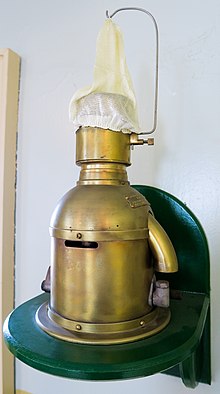
The vaporizedoil burnerwas invented in 1901 byArthur Kitson,and improved by David Hood atTrinity House.The fuel was vaporized at high pressure and burned to heat the mantle, giving an output of over six times the luminosity of traditional oil lights. The use of gas as illuminant became widely available with the invention of theDalén lightby Swedish engineerGustaf Dalén.He usedAgamassan(Aga), asubstrate,to absorb the gas, allowing the gas to be stored, and hence used, safely. Dalén also invented the 'sun valve', which automatically regulated the light and turned it off during the daytime.[This paragraph needs citation(s)]The technology was the predominant light source in lighthouses from the 1900s to the 1960s, when electric lighting had become dominant.[15]
Optical systems[edit]

With the development of the steady illumination of the Argand lamp, the application of optical lenses to increase and focus the light intensity became a practical possibility.William Hutchinsondeveloped the first practical optical system in 1777, known as acatoptricsystem.[16]This rudimentary system effectively collimated the emitted light into a concentrated beam, thereby greatly increasing the light's visibility.[17]The ability to focus the light led to the first revolving lighthouse beams, where the light would appear to the mariners as a series of intermittent flashes. It also became possible to transmit complex signals using the light flashes.
French physicist and engineerAugustin-Jean Fresneldeveloped the multi-partFresnel lensfor use in lighthouses. His design allowed for the construction of lenses of largeapertureand shortfocal length,without the mass and volume of material that would be required by a lens of conventional design. A Fresnel lens can be made much thinner than a comparable conventional lens, in some cases taking the form of a flat sheet. A Fresnel lens can also capture more oblique light from a light source, thus allowing the light from a lighthouse equipped with one to be visible over greater distances.
The first Fresnel lens was used in 1823 in theCordouan lighthouseat the mouth of theGironde estuary;its light could be seen from more than 20 miles (32 km) out.[18]Fresnel's invention increased theluminosityof the lighthouse lamp by a factor of four and his system is still in common use.
Modern lighthouses[edit]
The introduction of electrification andautomatic lamp changersbegan to makelighthouse keepersobsolete. For many years, lighthouses still had keepers, partly because lighthouse keepers could serve as arescue service,if necessary. Improvements in maritime navigation and safety, suchGlobal Positioning System(GPS), led to the phasing out of non-automated lighthouses across the world.[19]In Canada, this trend has been stopped and there are still 50 staffed light stations, with 27 on the west coast alone.[20]
The remaining modern lighthouses are usually illuminated by a single stationary flashing light powered by solar-charged batteries and mounted on a steel skeleton tower.[21]Where the power requirement is too great for solar power alone,cycle chargingof the battery by a Diesel generator is provided. The generator only comes into use when the battery needs charging, saving fuel and increasing periods between maintenance.[22]
Famous lighthouse builders[edit]
John Smeatonis noteworthy for having designed the third and most famousEddystone Lighthouse,but some builders are well known for their work in building multiple lighthouses. The Stevenson family (Robert,Alan,David,Thomas,David Alan,andCharles) made lighthouse building a three-generation profession in Scotland. Richard Henry Bruntondesigned and built 26Japanese lighthousesinMeiji EraJapan, which became known as Brunton's "children".[23]Blind IrishmanAlexander Mitchellinvented and built a number of screw-pile lighthouses. EnglishmanJames Douglasswas knighted for his work on the fourth Eddystone Lighthouse.[24]
United States Army Corps of EngineersLieutenantGeorge Meadebuilt numerous lighthouses along the Atlantic and Gulf coasts before gaining wider fame as the winning general at theBattle of Gettysburg.ColonelOrlando M. Poe,engineer toGeneral William Tecumseh Shermanin the siege of Atlanta, designed and built some of the most exotic lighthouses in the most difficult locations on the U.S.Great Lakes.[25]
French merchant navy officerMarius Michel Pashabuilt almost a hundred lighthouses along the coasts of theOttoman Empirein a period of twenty years after theCrimean War(1853–1856).[26]
Technology[edit]
In a lighthouse, the source of light is called the "lamp" (whether electric or fuelled by oil) and the light is concentrated, if needed, by the "lens" or "optic". Power sources for lighthouses in the 20th–21st centuries vary.
Power[edit]
Originally lit by open fires and later candles, theArgand hollow wick lampandparabolic reflectorwere introduced in the late 18th century.
Whale oilwas also used with wicks as the source of light.Kerosenebecame popular in the 1870s and electricity andacetylenegas derived on-site fromcalcium carbidebegan replacing kerosene around the turn of the 20th century.[21]Carbide was promoted by theDalén light,which automatically lit the lamp at nightfall and extinguished it at dawn.
In the second half of the 20th century, many remote lighthouses inRussia(thenSoviet Union) were powered byradioisotope thermoelectric generators(RTGs). These had the advantage of providing power day or night and did not need refuelling or maintenance. However, after the collapse of the Soviet government in 1990s, most of the official records on the locations, and condition, of these lighthouses were reportedly lost.[27]Over time, the condition of RTGs in Russia degraded; many of them fell victim to vandalism and scrap metal thieves, who may not have been aware of the dangerous radioactive contents.[28]
Energy-efficient LED lights can be powered bysolar panels,with batteries instead of a Diesel generator for backup.[29]
Light source[edit]
Many Fresnel lens installations have been replaced by rotatingaerobeacons,which require less maintenance.
In modern automated lighthouses, the system of rotating lenses is often replaced by a high intensity light that emits brief omnidirectional flashes, concentrating the light in time rather than direction. These lights are similar to obstruction lights used to warn aircraft of tall structures. Later innovations were "Vega Lights", and experiments withlight-emitting diode(LED) panels.[21]
LED lights, which use less energy and are easier to maintain, had come into widespread use by 2020. In the United Kingdom and Ireland about a third of lighthouses had been converted from filament light sources to use LEDs, and conversion continued with about three per year. The light sources are designed to replicate the colour and character of the traditional light as closely as possible. The change is often not noticed by people in the region, but sometimes a proposed change leads to calls to preserve the traditional light, including in some cases a rotating beam. A typical LED system designed to fit into the traditional 19th century Fresnel lens enclosure was developed by Trinity House and two other lighthouse authorities and costs about€20,000, depending on configuration, according to a supplier; it has large fins to dissipate heat. Lifetime of the LED light source is 50,000 to 100,000 hours, compared to about 1,000 hours for a filament source.[29]
Laser light[edit]
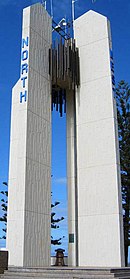
Experimental installations oflaserlights, either at high power to provide a "line of light" in the sky or, utilising low power, aimed towards mariners have identified problems of increased complexity in installation and maintenance, and high power requirements. The first practical installation, in 1971 atPoint Danger lighthouse,Queensland,was replaced by a conventional light after four years, because the beam was too narrow to be seen easily.[30][31]
Light characteristics[edit]
In any of these designs an observer, rather than seeing a continuous weak light, sees a brighter light during short time intervals. These instants of bright light are arranged to create alight characteristicor pattern specific to a lighthouse.[32]For example, theScheveningen Lighthouseflashes are alternately 2.5 and 7.5 seconds. Some lights have sectors of a particular color (usually formed by colored panes in the lantern) to distinguish safe water areas from dangerous shoals. Modern lighthouses often have unique reflectors orracon transpondersso the radar signature of the light is also unique.
Lens[edit]

Before modernstrobe lights,lenseswere used to concentrate the light from a continuous source. Vertical light rays of the lamp are redirected into a horizontal plane, and horizontally the light is focused into one or a few directions at a time, with thelight beamswept around. As a result, in addition to seeing the side of the light beam, the light is directly visible from greater distances, and with an identifyinglight characteristic.
This concentration of light is accomplished with a rotating lens assembly. In early lighthouses, the light source was akerosene lampor, earlier, an animal or vegetable oil Argand lamp, and the lenses rotated by a weight driven clockwork assembly wound by lighthouse keepers, sometimes as often as every two hours. The lens assembly sometimes floated inliquid mercuryto reduce friction. In more modern lighthouses, electric lights and motor drives were used, generally powered by diesel electric generators. These also supplied electricity for the lighthouse keepers.[21]
Efficiently concentrating the light from a large omnidirectional light source requires a very large diameter lens. This would require a very thick and heavy lens if a conventional lens were used. TheFresnel lens(pronounced/freɪˈnɛl/) focused 85% of a lamp's light versus the 20% focused with the parabolic reflectors of the time. Its design enabled construction of lenses of large size and short focal length without the weight and volume of material in conventional lens designs.[33]
Fresnel lighthouse lenses are ranked byorder,a measure of refracting power, with a first order lens being the largest, most powerful and expensive; and a sixth order lens being the smallest. The order is based on the focal length of the lens. A first order lens has the longest focal length, with the sixth being the shortest. Coastal lighthouses generally use first, second, or third order lenses, while harbor lights and beacons use fourth, fifth, or sixth order lenses.[34]
Some lighthouses, such as those atCape Race,Newfoundland, andMakapuu Point,Hawaii, used a more powerfulhyperradiant Fresnel lensmanufactured by the firm ofChance Brothers.
Building[edit]
Components[edit]

While lighthouse buildings differ depending on the location and purpose, they tend to have common components.
A light station comprises the lighthouse tower and all outbuildings, such as the keeper's living quarters, fuel house, boathouse, andfog-signalingbuilding. The Lighthouse itself consists of a tower structure supporting the lantern room where the light operates.
The lantern room is the glassed-in housing at the top of a lighthouse tower containing the lamp and lens. Its glass storm panes are supported by metalmuntins(glazing bars) running vertically or diagonally. At the top of the lantern room is a stormproof ventilator designed to remove the smoke of the lamps and the heat that builds in the glass enclosure. Alightning rodand grounding system connected to the metal cupola roof provides a safe conduit for any lightning strikes.
Immediately beneath the lantern room is usually a Watch Room or Service Room where fuel and other supplies were kept and where the keeper prepared the lanterns for the night and often stood watch. The clockworks (for rotating the lenses) were also located there. On a lighthouse tower, an open platform called the gallery is often located outside the watch room (called the Main Gallery) or Lantern Room (Lantern Gallery). This was mainly used for cleaning the outside of the windows of the Lantern Room.[35]
Lighthouses near to each other that are similar in shape are often painted in a unique pattern so they can easily be recognized during daylight, a marking known as adaymark.The black and white barber pole spiral pattern ofCape Hatteras Lighthouseis one example.Race Rocks Lightin western Canada is painted in horizontal black and white bands to stand out against the horizon.
Design[edit]
For effectiveness, the lamp must be high enough to be seen before the danger is reached by a mariner. The minimum height is calculated by trigonometry (seeDistance to the horizon) as,whereHis the height above water in feet, andDis the distance from the lighthouse to the horizon in nautical miles, thelighthouse range.[36]
Where dangerous shoals are located far off a flat sandy beach, the prototypical tall masonry coastal lighthouse is constructed to assist the navigator making a landfall after an ocean crossing. Often these are cylindrical to reduce the effect of wind on a tall structure, such asCape May Light.Smaller versions of this design are often used as harbor lights to mark the entrance into a harbor, such asNew London Harbor Light.
Where a tall cliff exists, a smaller structure may be placed on top such as atHorton Point Light.Sometimes, such a location can be too high, for example along the west coast of the United States, where frequent low clouds can obscure the light. In these cases, lighthouses are placed below the clifftop to ensure that they can still be seen at the surface during periods of fog or low clouds, as atPoint Reyes Lighthouse.Another example is inSan Diego,California:theOld Point Loma lighthousewas too high up and often obscured by fog, so it was replaced in 1891 with a lower lighthouse,New Point Loma lighthouse.[This paragraph needs citation(s)]
As technology advanced, prefabricated skeletal iron or steel structures tended to be used for lighthouses constructed in the 20th century. These often have a narrow cylindrical core surrounded by an open lattice work bracing, such asFinns Point Range Light.
Sometimes a lighthouse needs to be constructed in the water itself. Wave-washed lighthouses are masonry structures constructed to withstand water impact, such asEddystone Lighthousein Britain and theSt. George Reef Lightof California. In shallower bays,Screw-pile lighthouseironwork structures are screwed into the seabed and a low wooden structure is placed above the open framework, such asThomas Point Shoal Lighthouse.As screw piles can be disrupted by ice, steel caisson lighthouses such asOrient Point Lightare used in cold climates.Orient Long Beach Bar Light(Bug Light) is a blend of a screw pile light that was converted to a caisson light because of the threat of ice damage.[37]Skeletal iron towers with screw-pile foundations were built on theFlorida Reefalong the Florida Keys, beginning with theCarysfort Reef Lightin 1852.[38]
In waters too deep for a conventional structure, alightshipmight be used instead of a lighthouse, such as the formerlightshipColumbia.Most of these have now been replaced by fixed light platforms (such asAmbrose Light) similar to those used for offshore oil exploration.[34]
Range lights[edit]
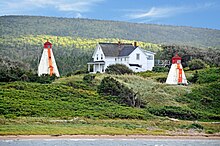
Aligning two fixed points on land provides a navigator with aline of positioncalled a range in North America and atransitin Britain. Ranges can be used to precisely align a vessel within a narrow channel such as a river. With landmarks of a range illuminated with a set of fixed lighthouses, nighttime navigation is possible.
Such paired lighthouses are calledrange lightsin North America andleading lightsin the United Kingdom. The closer light is referred to as the beacon or front range; the further light is called the rear range. The rear range light is almost always taller than the front.
When a vessel is on the correct course, the two lights align vertically, but when the observer is out of position, the difference in alignment indicates the direction of travel to correct the course.
Location[edit]


There are two types of lighthouses: ones that are located on land, and ones that are offshore.
Offshore Lighthousesare lighthouses that are not close to land.[39]There can be a number of reasons for these lighthouses to be built. There can be ashoal,reefor submergedislandseveral miles from land.
The currentCordouan Lighthousewas completed in 1611, 7 kilometres (4.3 mi) from the shore on a small islet, but was built on a previous lighthouse that can be traced back to the 880s and is the oldest surviving lighthouse inFrance.It is connected to the mainland by a causeway. The oldest surviving oceanic offshore lighthouse isBell Rock Lighthousein theNorth Sea,off the coast ofScotland.[40]
Maintenance[edit]
Asia and Oceania[edit]
InAustralia,lighthouses are conducted by theAustralian Maritime Safety Authority.
InIndia,lighthouses are maintained by the Directorate General of Lighthouses and Lightships, an office of theMinistry of Ports, Shipping and Waterways.[41]
Europe[edit]
The former Soviet government built a number of automated lighthouses powered byradioisotope thermoelectric generatorsin remote locations in northern Russia. They operated for long periods without external support with great reliability.[42]However, numerous installations deteriorated, were stolen, or vandalized. Some cannot be found due to poor record-keeping.[43]
TheUnited Kingdomand theRepublic of Irelandtogether have three bodies: lighthouses around the coasts of England and Wales are looked after byTrinity House,those around Scotland and the Isle of Man by theNorthern Lighthouse Boardand those around Ireland by theCommissioners of Irish Lights.
North America[edit]
In Canada, lighthouses are managed by theCanadian Coast Guard.
In the United States, lighthouses are maintained by theUnited States Coast Guard,into which theUnited States Lighthouse Servicewas merged in 1939.[34]
Preservation[edit]
As lighthouses became less essential to navigation, many of their historic structures faced demolition or neglect. In the United States, theNational Historic Lighthouse Preservation Actof 2000 provides for the transfer of lighthouse structures to local governments and private non-profit groups, while the USCG continues to maintain the lamps and lenses. In Canada, theNova Scotia Lighthouse Preservation Societywon heritage status forSambro Island Lighthouse,and sponsored theHeritage Lighthouse Protection Actto change Canadian federal laws to protect lighthouses.[44]
Many groups formed to restore and save lighthouses around the world, including theWorld Lighthouse Societyand theUnited States Lighthouse Society,[45]as well as theAmateur Radio Lighthouse Society,which sends amateur radio operators to publicize the preservation of remote lighthouses throughout the world.[46]
See also[edit]
- Crib lighthouse
- Day beacon
- Foghorn
- Fresnel lens sizes (orders)
- Lens lantern
- Lighthouse keeper
- Lists of lighthouses
- Lists of lightvessels
- Pharology
- Pintsch gas
- Sea mark
References[edit]
- Notes
- ^Trethewey, K. R.:Ancient Lighthouses, Jazz-Fusion Books (2018), 326pp.ISBN978-0-99265-736-9
- ^Smiles, Samuel (1861),The Lives of the Engineers,vol. 2, p. 16
- ^"lighthouse".Retrieved17 December2012.
- ^Majdalany, Fred:The Eddystone Light.1960
- ^"Eddystone – Gallery".Trinity House. Archived fromthe originalon 9 September 2006.Retrieved3 May2010.
- ^Douglass, James Nicholas (1878)."Note on the Eddystone Lighthouse".Minutes of proceedings of the Institution of Civil Engineers.Vol. 53, part 3. London: Institution of Civil Engineers. pp. 247–248.
- ^ab"NLB – Robert Stevenson".Retrieved28 January2013.
- ^Boucher, Cyril Thomas Goodman (1963),John Rennie, 1761–1821: The Life and Work of a Great Engineer,p. 61
- ^abTomlinson, ed. (1852–1854).Tomlinson's Cyclopaedia of Useful Arts.London: Virtue & Co. p.177.
[Maplin Sands] was not, however, the first screw-pile lighthouse actually erected, for during the long preparation process which was carried on at Maplin Sands, a structure of the same principle had been begun and completed at Port Fleetwood...
- ^"Lamp Glass Replacement Glass Lamp Shades, Oil Lamp Shades, Oil Lamp Chimneys, Oil Lamp Spares".Archived fromthe originalon 6 January 2014.
- ^"Lamp."Encyclopædia Britannica: or, a dictionary of Arts, Science, and Miscellaneous Literature.6th ed. 1823Web.5 December 2011
- ^"Modern Lighthouses".Encyclopædia Britannica.Retrieved4 August2021.
- ^Baird, Spencer Fullerton (1876).Annual record of science and industry.New York: Harper & Brothers. p. 460.
- ^"John Richardson Wigham 1829–1906"(PDF).BEAM.35.Commissioners of Irish Lights: 21–22. 2006–2007. Archived fromthe original(PDF)on 12 March 2012.
- ^"The Linde Group - Gases Engineering Healthcare -".Archived fromthe originalon 18 October 2015.Retrieved6 April2017.
- ^"Illumination, Refraction, Fresnel Lens".Encyclopedia Britannica.9 October 1998.Retrieved2 June2024.
- ^"Lighthouse".Encyclopædia Britannica.Retrieved6 January2014.
- ^Watson, Bruce. "Science Makes a Better Lighthouse Lens."Smithsonian.August 1999 v30 i5 p30. produced inBiography Resource Center.Farmington Hills, Mich.: Thomson Gale. 2005.
- ^"Maritime Heritage Program - National Park Service".Retrieved6 April2017.
- ^"Lighthouses of British Columbia".Archived fromthe originalon 3 November 2011.Retrieved3 November2011.
- ^abcdCrompton & Rhein (2002)
- ^Nicholson, Christopher (2000).Rock lighthouses of Britain: The end of an era?.Caithness, Scotland: Whittles. p. 126.ISBN978-1870325417.
- ^"Obituary - Richard Henry Brunton".Minutes of the Proceedings of the Institution of Civil Engineers.Vol. 145, no. 1901. 1901. pp. 340–341.doi:10.1680/imotp.1901.18577.Retrieved20 April2018.
- ^
 Beare, Thomas Hudson (1901). "Douglass, James Nicholas". InLee, Sidney(ed.).Dictionary of National Biography(1st supplement).London: Smith, Elder & Co.
Beare, Thomas Hudson (1901). "Douglass, James Nicholas". InLee, Sidney(ed.).Dictionary of National Biography(1st supplement).London: Smith, Elder & Co.
- ^"Maritime Heritage Program - National Park Service".Retrieved6 April2017.
- ^Guigueno, Vincent (January 2006)."Review of Thobie, Jacques, L'administration generale des phares de l'Empire ottoman et la societe Collas et Michel, 1860–1960. H-Mediterranean, H-Net Reviews. January, 2006".Humanities and Social Sciences Net Online.Retrieved20 September2010.
- ^"Nuclear lighthouses to be replaced - Bellona".June 23, 2011. Archived fromthe originalon 2011-06-23.
- ^"Radioisotope Thermoelectric Generators - Bellona".March 15, 2011. Archived fromthe originalon 2011-03-15.
- ^abBaraniuk, Chris (15 September 2020)."When changing a light bulb is a really big deal".BBC News.Archivedfrom the original on Jun 19, 2023.
- ^"Point Danger Lighthouse".Lighthouses of Australia Inc. 26 January 2018.Retrieved11 August2020.
- ^"Lasers".Aids to Navigation Manual.St Germain en Laye, France:International Association of Marine Aids to Navigation and Lighthouse Authorities:43. March 2010.
- ^"Aids To Navigation Abbreviations".Archived fromthe originalon September 25, 2008.
- ^"Lighthouses: An Administrative History".Maritime Heritage Program – Lighthouse Heritage.U.S. National Park Service.Retrieved10 June2008.
- ^abc"Maritime Heritage Program | National Park Service".nps.gov.
- ^"Light Station Components".nps.gov.
- ^"How to Calculate the Distance to the Horizon".
- ^"Maritime Heritage Program - National Park Service".Retrieved6 April2017.
- ^Dean, Love (1982).Reef Lights.Key West, Florida: The Historic Key West Preservation Board.ISBN0-943528-03-8.
- ^"Lighthouse Terminology Part 2",Sea Girt Lighthouse,archived fromthe originalon 4 April 2013,retrieved15 February2013,
A lighthouse located offshore, built on a foundation of pilings, rocks or caissons.
- ^Cadbury, Deborah (2012),Seven Wonders of the Industrial World(Text only ed.), HarperCollins UK, p. 106,ISBN978-0007388929.
- ^R.K. Bhanti."Indian Lighthouses - An Overview"(PDF).Directorate General of Lighthouses and Lightships.Retrieved27 November2019.
- ^"RTG Heat Sources: Two Proven Materials - Atomic Insights".1 September 1996.Retrieved6 April2017.
- ^"Radioisotope Thermoelectric Generators – Bellona".Archived fromthe originalon June 13, 2006.
- ^Douglas Franklin."Lighthouse Bill Protecting Our Lighthouses – The Icons of Canada's Maritime Heritage".Featured Heritage Buildings.Canadian Heritage Foundation. Archived fromthe originalon 13 May 2008.Retrieved10 June2008.
- ^"Home | United States Lighthouse Society".uslhs.org.
- ^"Amateur Radio Lighthouse Society – Contacting the Light Beacons of the World".Retrieved6 April2017.
- Bibliography
- Bathurst, Bella.The lighthouse Stevensons.New York: Perennial, 2000.ISBN0-06-093226-0
- Beaver, Patrick.A History of Lighthouses.London: Peter Davies Ltd, 1971.ISBN0-432-01290-7.
- Crompton, Samuel, W; Rhein, Michael, J.The Ultimate Book of Lighthouses.San Diego, CA: Thunder Bay Press, 2002.ISBN1-59223-102-0.
- Jones, Ray; Roberts, Bruce.American Lighthouses.Globe Pequot, 1998. 1st ed.ISBN0-7627-0324-5.
- Stevenson, D. Alan.The world's lighthouses before 1820.London:Oxford University Press,1959.
Further reading[edit]
- Noble, Dennis.Lighthouses & Keepers: U. S. Lighthouse Service and Its Legacy.Annapolis: U.S. Naval Institute Press, 1997.ISBN1-55750-638-8.
- Putnam, George R.Lighthouses and Lightships of the United States.Boston: Houghton Mifflin Co., 1933.
- Rawlings, William. 2021.Lighthouses of the Georgia Coast.Macon, GA: Mercer University Press.
- Weiss, George.The Lighthouse Service, Its History, Activities and Organization.Baltimore: Johns Hopkins Press, 1926.
External links[edit]
- United States Lighthouses
- "Lighthouses Of Strange Designs, December 1930, Popular Science
- Rowlett, Russ."The Lighthouse Directory".University of North Carolina at Chapel Hill.Research tool with details of over 14,700 lighthouses and navigation lights around the world with photos and links.
- Pharology Website:Pharology: The Study of Lighthouses.Reference source for the history and development of lighthouses of the world.
- Douglass, W. T.; Gedye, N. G. (1911)..Encyclopædia Britannica.Vol. 16 (11th ed.). pp. 627–651.Includes 54 diagrams and photographs.



